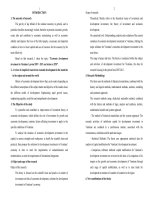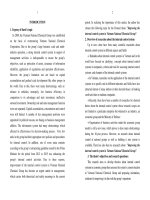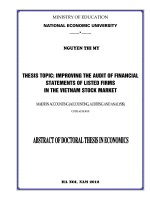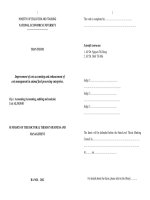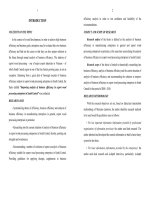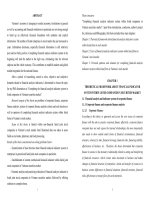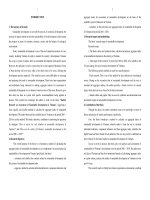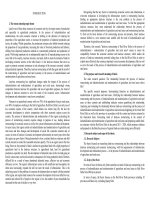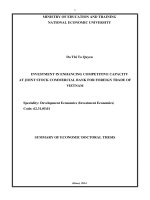Tóm tắt tiếng anh: Impact of health insurance in Vietnam on healthcare utilization, selfreported health, and financial choices.
Bạn đang xem bản rút gọn của tài liệu. Xem và tải ngay bản đầy đủ của tài liệu tại đây (390.79 KB, 28 trang )
1
MINISTRY OF EDUCATION AND TRAINING
UNIVERSITY OF ECONOMICS HO CHI MINH CITY
--------------
TRUONG ANH TUAN
IMPACTS OF HEALTH INSURANCE IN
VIETNAM ON HEALTHCARE
UTILIZATION, SELF-REPORTED
HEALTH, AND FINANCIAL CHOICES
SUMMARY OF DOCTORAL THESIS
2
MINISTRY OF EDUCATION AND TRAINING
UNIVERSITY OF ECONOMICS HO CHI MINH CITY
--------------
TRUONG ANH TUAN
IMPACTS OF HEALTH INSURANCE IN
VIETNAM ON HEALTHCARE
UTILIZATION, SELF-REPORTED
HEALTH, AND FINANCIAL CHOICES
Major: Economic development
Code: 9310105
Academic advisors:
1. Dr. Le Thanh Loan
2. Assoc. Prof. Dr. Pham Khanh Nam
1
The research was conducted and completed at University of
Economics Ho Chi Minh City:
Academic advisors:
1. Dr. Le Thanh Loan
2. Assoc. Prof. Dr. Pham Khanh Nam
Reviewer 1: ..................................................................
......................................................................................
Reviewer 2: ..................................................................
......................................................................................
Reviewer 3: :...............................................................
......................................................................................
The thesis will be defended at University of
Economics Ho Chi Minh City
At
hour
day
month
year
The thesis can be found at the following library:
…………….………………
1
Chapter 1: INTRODUCTION
Background
As health insurance coverage is being extended in Vietnam, research
into the policy's effects has become a high concern. In reality, there
have been a number of studies on the impact of health insurance on
vulnerable groups. However, most of the research has only focused on
children and the poor. The free health insurance program for the
Vietnamese elderly generates a natural experiment that may be
utilized to evaluate the effects and supplement existing empirical
findings on moral hazard.
In Vietnam, co-payments were first introduced in 1998, but the effect
of pharmaceutical cost-sharing policies on health outcomes in the
Vietnamese healthcare setting has not been studied yet. The question
of whether or not co-payments reduce healthcare utilization and
therefore affect individuals' health status remains unanswered.
Enrolling in health insurance is assumed to have an impact on other
financial services such as savings, borrowing, investing, and other
insurance in a household. However, there is little empirical evidence
to support the link between health insurance and financial services for
families in Low- and middle-income countries (LMICs). No research
has been conducted on the impact of health insurance on other
financial services in Vietnamese households.
Health insurance and healthcare scheme in Vietnam
1.2.1. Development of health insurance in Vietnam
Vietnamese health insurance has been in place for almost 29 years. It
had been piloted in some provinces before 1992, including Hai Phong,
2
Quang Tri, and Vinh Phu. The government issued Decree 299/HBT
on August 15, 1992, and it was in force from 1992 to 1998.
1.2.2. Healthcare scheme in Vietnam
Payments in health insurance in Vietnam are basically made on a
tripartite basis. The insured pay The Vietnam Social Security Agency
(VSS) premiums, but they also pay co-payments when they visit a
healthcare facility for a medical examination and treatment. The
contracted providers are responsible for delivering services to insured
individuals and claiming reimbursement from the VSS (Ha et al.,
2021).
Objectives of thesis
This thesis’s objectives are as follows:
1. To assess the degree to which the health insurance program for the
elderly facilitates healthcare utilization and provides financial
protection to covered individuals.
2. To explore the impacts of having health insurance on households'
choices of financial services such as private insurance, savings,
investments, and credit.
3. To examine the impacts of health insurance co-payments in
Vietnam on the self-reported health of those covered by the plan.
Research questions
Based on the research objectives, the specific research questions are
as follows:
1. What are the impacts of health insurance for the elderly on the
probability of an outpatient visit, the probability of an inpatient visit,
the number of outpatient visits, the number of inpatient visits, the
expenditures per outpatient visit, and the expenditures per inpatient
visit?
3
2. What impacts does health insurance have on households' choices of
private insurance, savings, investments, and credit?
3. What impact do co-payments in health insurance have on reported
health among the insured?
Scope of the thesis
For the research on the effects of health insurance on healthcare use
and out-of-pocket expenditures, the current study centers only on the
behaviors of elderly adults aged around 80 years in rural regions of 63
provinces and cities in Vietnam. The scope of this study on the effects
of health insurance on household financial choices is restricted to rural
households living in the provinces of Ha Tinh, Thua Thien Hue, and
Dak Lak. The boundary of the study on the effect of the co-payment
program on health status is limited to rural individuals in the provinces
of Ha Tinh, Thua Thien Hue, and Dak Lak.
Structure of the thesis
The thesis is organized in an essay-based format, with three essays
addressing different health insurance-related impacts in Vietnam.
This thesis is divided into six major chapters.
Chapter 2: THEORY AND LITERATURE REVIEW
Theoretical backgrounds
2.1.1. Model of demand for health
The Grossman model of demand for health has been generally applied
in the health economic field by many researchers (Mwabu, 2007). In
Grossman’s model, people are endowed with an initial stock of health,
which depreciates over the years, but can be increased by investment.
Individuals invest in health by consuming healthcare and also
combining exercise, diet, and time. These investments help to
4
maintain or improve people’s stocks of health, which in turn provide
them with healthy days (Folland et al., 2013).
2.1.2. Behavioral model of health services utilization
This model was originally developed by Ronald M. Andersen in the
1960s to explain why families utilize healthcare, then revised by
himself, and it has gone through four phases (Andersen, 1995). In this
model, Andersen revealed that the utilization of health services is a
function of three groups of factors, including predisposing factors,
enabling factors, and need factors.
2.1.3. Moral hazard
Moral hazard can be divided into two distinct types, which are called
ex-ante moral hazard and ex-post moral hazard (Chun-Wei Lin, 2012).
Essentially, both types of moral hazard behaviors occur following
individuals purchasing insurance. Ex-ante moral hazard refers to the
phenomena prior to the advent of illness in which insured individuals
engage in risky health behaviors, increasing the probability of a loss.
Ex-post moral hazard is related to the increased consumption of
healthcare services once an event of illness has occurred (Jowett et al.,
2004).
2.1.4. Moral hazard and Cost-sharing
To reduce the social welfare losses due to moral hazards in
healthcare, health economics justifies the use of cost-sharing as a
policy tool (e.g., a deductible, co-payment, or co-insurance) to limit
the utilization of healthcare services (Folland et al., 2013).
2.1.5. Theory of precautionary savings
The basic implication of the theory is that individuals, in the presence
of uncertain future income, are likely to diminish consumption and
save more.
5
Conceptual framework
Figure 2.1: Conceptual framework for the thesis
Program evaluations
2.3.1. Program impact measures
There are a range of program effect measures, and the choice of which
measure to employ will depend on the policy topic of interest. A few
of the measures include Average Treatment Effect (ATE), Average
Treatment Effect of the Treated (ATT), Local Average Treatment
Effect (LATE).
2.3.2. Program impact evaluation methods
The program is not assigned randomly but rather based on the needs
of communities and individuals who then self-select the program
(Khandker et al., 2009). As a result, participants have different
characteristics that make them more likely to join the program than
6
non-participants and also impact their outcomes. Selection bias is the
term used to describe this phenomenon (Becker & Caliendo, 2007).
The use of experimental and quasi-experimental approaches is
motivated by the goal of eliminating selection bias.
Empirical literature review and research gaps
2.4.1. Review of key findings
Impacts of health insurance on healthcare utilization and
out-of-pocket expenditures
The current understanding of the impacts of health insurance on
healthcare utilization and out-of-pocket expenditure of the elderly in
LMICs is inadequate at the moment due to a scarcity of literature and
inconsistent findings from current studies. Mixed and limited findings
rationalize the need to further investigate the impacts of health
insurance on the elderly. In this regard, the present thesis seeks to
cover some such gaps by evaluating the effects of health insurance on
healthcare utilization and out-of-pocket expenditures of the elderly in
Vietnam.
1.3.2.3. Impacts of health insurance on households’ financial
service choices
In developing countries, households often include several financial
services in their risk management strategies; thus, the correlations
between these services should be taken into account. It emphasizes the
importance of more research into the impact of health insurance on
concurrent financial services in order to present a more detailed
picture of the effects and to account for their correlations.
1.3.2.4. The impact of cost-sharing on health
There is a paucity of studies examining the effects of cost-sharing on
either overall self-reported health or disease-specific health. The
7
results are mixed, which highlights the need for more research to be
conducted. Because the vast majority of previous research was carried
out in developed countries, the conclusions drawn from those studies
may not be applicable to countries that are still in the process of
developing. This indicates that research is even more urgently needed
in developing countries.
2.4.2. Review of methodologies
Methodologies for studies on the impacts of health
insurance on healthcare utilization and out-of-pocket
expenditures
The methodological choices used for each study are mostly driven by
the exogenous changes induced by a change in a health policy or the
implementation of a new program. And because most research uses
secondary data, the availability of data in the countries where the
authors want to do studies also affects the methods used.
Methodologies for studies on the impacts of health
insurance on households’ financial services
While there is empirical evidence of correlations between financial
services, previous research examining the impact of health insurance
on financial services using quasi-experimental approaches overlooked
the correlations.
Methodologies for studies on the impact of cost-sharing
on health
An issue with measuring the effects of a program is that participants
are not assigned to the program at random. This means that there may
be factors affecting program participation and outcomes that were not
observable by the researcher, resulting in selection bias. In examining
a cost-sharing program, the term "selection bias" is less intuitive since
8
a person cannot self-select to be exempted from cost-sharing.
However, selection bias may also exist in this case due to omitted
variable bias, which occurs when an omitted variable is correlated
with both treatment and outcome.
Justification of analytical methodologies
Methodology for research on impacts of health insurance on
healthcare utilization and expenditures
In the Vietnamese context, randomized controlled trials (RCTs) are
infeasible due to the fact that health insurance is a legislated policy for
all people; hence we cannot randomly assign health insurance to
individuals. Given this, I have to settle for the next best possible
choice: a quasi-experimental strategy (the regression discontinuity
design: RDD).
Methodology for research on impacts of health insurance on
households’ financial services
In order to address the interconnected nature of various financial
products, I decided to use multivariate probit regression to examine
the impact of health insurance on private insurance, savings,
investments, and credit choices.
Methodology for research on the impact of co-payments on health
After ruling out the possibility of RCTS, I resort to a quasi-experiment,
the PSM method, in an attempt to minimize selection bias in the study.
Chapter 3: IMPACTS OF HEALTH INSURANCE ON
HEALTHCARE UTILIZATION AND OUT-OF-POCKET
EXPENDITURES
Introduction
The current understanding of the health-seeking behaviors of the
elderly in LMICs is inadequate at the moment due to a scarcity of
9
literature and inconsistent findings from current studies. This paper
bridges this gap by particularly examining the impact of a public
health insurance program for the elderly on healthcare use in rural
Vietnam.
Conceptual framework
The conceptual framework for this research is based on a theory and
two models, including moral hazard theory, Grossman's model, and
Andersen's behavioral model.
Methods
3.3.1. Model specification
As indicated by Lee & Lemieux (2010), the regression model for the
fuzzy RDD basically includes two stages as follows:
First stage: Di =α0 + α1 T + f agei + α2 Xi + vi
(2)
Second stage: Yi =β0 + β1 Di + g agei +
(3)
2 Xi
+ ei
Where Di is a binary variable of insurance status for individual i. Di is
the predicted value of the probability of being insured obtained from
equation (2). Ti is a binary variable that indicates whether an
individual belongs to the treatment group (age ≥ 80 years), and serves
as an instrumental variable (IV) for insurance status. agei refers to the
age of an individual. f(.) is the smooth function of age and health
insurance status; g(.) is the smooth function of age and the outcomes.
X'i is a vector of control variables. vi and ei are random error terms.
3.3.2. Data and variables
In the baseline analysis, the thesis uses four waves of VHLSS data in
the years 2012, 2014, 2016, and 2018, which were all fielded after the
health insurance program was effective for the elderly. In the baseline
model, the sample is limited to the elderly aged 70 to 89 years old
10
living in rural areas. In addition, I employ the wave of 2010, a prepolicy dataset, for a placebo check.
Results
3.4.1. Impacts of the health insurance program for the elderly on
the probability of being insured
Estimates reveal that reaching the age of 80 significantly increases the
probability of being insured by over six percentage points. And the
increase is the same across three specifications of running variable
(age).
3.4.2. Impacts of health insurance on healthcare utilization
outcomes
The program increases the probability of an inpatient visit, the number
of inpatient visits, and expenditures per inpatient visit; however, the
coefficients are not statistically significant. The program's impact on
the number of outpatient visits loses its statistical significance at any
conventional level. It is somewhat surprisingly noted that the program
statistically decreases the probability of an outpatient visit by nearly
63%. The study finds a negative impact of the health insurance
program on expenditures per outpatient visit.
Model significance testing
3.5.1. Validity of RDD
The validity of my analysis hinges on the assumption that individuals
are not able to precisely manipulate the running variable in close
proximity to the threshold (Lee & Lemieux, 2013). On the whole, I
find no evidence of manipulation of individuals at the threshold, thus
supporting the validity of RDD.
11
3.5.2. Robustness checks
The robustness of the baseline results will be verified by narrowing
down the window size around the cutoff point. The findings from the
robustness checks are that the impact of the health insurance program
on expenditures per outpatient visit is statistically significant with
smaller samples.
Discussion
The findings imply that health insurance reform strategies based only
on universal health coverage may be insufficient to expand healthcare
access in LMICs. This issue was also mentioned by M. T. Nguyen
(2020) when studying the effects of free health insurance for children
in Vietnam.
Conclusion
The most remarkable finding to emerge from this research is that the
health insurance program for the elderly in Vietnam causes no moral
hazard effect. This result does not confirm previous research carried
out in this area in LMICs. However, it serves as evidence that the
health-seeking behavior of the middle-old in the presence of insurance
may be different from that of other generations.
Chapter 4: IMPACTS OF HEALTH INSURANCE ON
HOUSEHOLDS’ FINANCIAL CHOICES: EVIDENCE FROM
VIETNAM
Introduction
When assessing the impact of health insurance, one important issue
that
previous
research
has
generally
overlooked
is
the
interconnectedness of financial services. In practice, households may
use a variety of financial services, some of which correlate with one
another (Farrell et al., 2016; Giesbert et al., 2011; Viganò &
12
Castellani, 2020). Hence, in the presence of correlations, estimates
from separate equations of financial service choices are inefficient
(Belderbos et al., 2004; Greene, 2012); additionally, these estimates
do not tell the whole story of how health insurance affects financial
tools in households' risk management baskets.
Controlling for endogeneity is a task that researchers investigating the
impact of health insurance coverage on financial service choice have
to perform. In this study, I use a recursive multivariate probit model
to
circumvent endogeneity
issues
caused
by
unobserved
heterogeneity.
Data and variables
4.2.1. Data source
This research is based on data from the Thailand-Vietnam
Socioeconomic Panel (TVSEP) project. I use data from three waves,
in 2013, 2016, and 2017, but limit my sample to Vietnamese
households that supply the relevant information.
4.2.2. Variable definitions and descriptive statistics
I include five dependent variables. The status of health insurance is
the most important dependent variable. It is a binary indicator that
denotes whether a family is covered by either government or private
health insurance but not by the government's free health card. Four
financial service choices are also dependent variables. These variables
indicate whether households used private insurance, savings,
investments, or credit in the previous year. Assuming that household
characteristics influence the likelihood of obtaining financial services,
the vector of control variables in my analysis contains a range of sociodemographic factors.
13
Conceptual framework
The theory of precautionary savings provides the conceptual basis for
this research. By making sure a family has access to healthcare
services, health insurance reduces the uncertainty about future health
costs. As a result of this financial protection, it is expected that various
changes will occur in categories such as private insurance, savings,
investment, and credit.
Research hypotheses and methods
4.4.1. Research hypotheses
Hypothesis 1: Health insurance positively affects private
insurance
Hypothesis 2: Health insurance has a positive impact on savings
Hypothesis 3: Health insurance has a positive impact on
investments
Hypothesis 4: Health insurance has a negative impact on credit
choice
4.4.2. Research methods
The model in this study is a recursive five-equation system with a
reduced equation for health insurance coverage and structural form
equations for each of the four financial service choices: private
insurance, savings, investments, and credit. Let Y , , , , =
{Y , Y , Y , Y , Y } denote a vector of five dummies representing,
in that order, health insurance, private insurance, savings, investments,
and credit.
Y ∗ = β X + γ R + ε
(1)
∗
(2)
∗
(3)
∗
(4)
Y = α Y + β X + ε
Y = α Y + β X + ε
Y = α Y + β X + ε
14
Y ∗ = α Y + β X + ε
1,
if Y ∗ > 0
Y =
0,
if Y ∗ ≤ 0
1,
if Y ∗, , , > 0
Y, , , =
0,
if Y ∗, , , ≤ 0
(5)
X is a vector of exogenous variables that is identical in all five
equations. R is an instrumental variable (IV) which is the government
health insurance coverage rate in a district. The error terms ε ,
ε , ε , ε , and ε follow a multivariate normal distribution.
ε
⎛ε ⎞
⎜ε ⎟ ~N(0, ∑ ), of which, ∑ =
ε
⎝ε ⎠
1
ρ
1
⎛
⎞
ρ
ρ
1
⎜
⎟
ρ
ρ
ρ
1
ρ
ρ
ρ
1⎠
⎝ρ
Empirical strategy for robustness checks
To test the robustness of the coefficients in the multivariate probit
model, I treat the data set as a panel data set. I examine the effect of
health insurance on private insurance, savings, investments, and credit
using an IV two-stage least-squares model that ignores the binary
nature of treatment and outcome variables as well as their
interconnectedness. Thus, I adopt the model:
Y =
+ θ X + φ R + ε
(6)
Y
=
+ ω Y + θ X + ε
(7)
Y
=
+ ω Y + θ X + ε
(8)
15
Y
=
+ ω Y + θ X + ε
(9)
Y
=
+ ω Y + θ X + ε
(10)
Where Y
is health insurance status of household i at time t, X
denotes a vector of exogenous variables. R is the IV, which is the
district's coverage rate of government health insurance. Y , , , =
{Y
,Y
,Y
, Y } is a vector of four dummies representing, in that
order, private insurance, savings, investments, and credit of household
i at time t.
As another robustness check, this research estimates recursive
bivariate probit regressions for each pair of insurance and financial
choices.
Results
4.5.1. Impacts of covariates
The percentage of homes covered by government health insurance in
a district is positively connected with the chance of a household
getting health insurance in that district. Risk attitude has a positive
correlation with savings, investments, and credit. Surprisingly, risk
attitude is positively related to two forms of insurance.
With reference to household heads’ characteristics, male-headed
families are less likely to have credit than female-headed households.
Households with an older head have a larger likelihood of purchasing
private insurance; however, the negative coefficients of age squared
suggest that this likelihood declines at a certain age. Married heads of
household have a positive association with private insurance. In
comparison to families headed by members of ethnic minorities,
households headed by members of the King majority were more likely
to have health insurance. Furthermore, Kinh households have a greater
likelihood of investing than ethnic minority families. The number of
16
school years spent by household heads is positively associated with
the chance of the household purchasing insurance, saving, and
investing.
Regarding households’ characteristics, interestingly, insurance is
adversely connected with the health status of family members.
Households with a greater number of members are more likely to
purchase insurance, invest, and utilize credit than households with
fewer members. Asset value is positively correlated with health
insurance but negatively correlated with investments. Families who
receive a greater amount of remittance are more likely to save and
invest. The number of members of sociopolitical organizations
contributes to the likelihood of obtaining insurance, investing, and
credit. Households with more wage earners had a higher probability
of purchasing insurance and obtaining credit but a lower probability
of saving. In terms of shocks, natural shocks reduce the likelihood of
having health insurance and savings but raise the likelihood of
investing and obtaining credit. Social shocks decrease both the
propensity to get private insurance and to save. Households that have
been subjected to economic shocks tend to purchase less insurance and
save less but have more credit. Crime shocks have a negative
relationship with savings but a positive relationship with credit.
4.5.2. Impact of health insurance on financial choices
The sign of the coefficients in the multivariate probit model indicates
that enrolling in health insurance increases families' probability of
saving and investing but decreases their probability of gaining further
credit.
17
4.5.3. Correlations between the error terms
There is a positive correlation between the residuals in the health
insurance and credit equations. There is a strong and negative
correlation between residuals in health insurance and savings
equations.
Robustness checks
The two-stage least-squares random-effects technique and recursive
bivariate probit regressions replicate the multivariate probit model's
findings regarding the impact of health insurance on financial service
choices. It could hence be said that multivariate probit findings are
robust to alternative econometric techniques.
Conclusion
The results indicate that while health insurance has no influence
on private insurance, it has a positive effect on savings and
investments and a negative effect on credit, and these results are robust
to different econometric specifications. The effects demonstrate that
health insurance plays a role in enhancing the financial well-being of
families. Additionally, the pattern of residual correlations in financial
service equations shows that, to some degree, the linkages between
financial services might be regarded as substitutes or supplements for
families.
Chapter 5: THE IMPACTS OF CO-PAYMENTS ON SELFREPORTED HEALTH AMONG THE HEALTH INSURANCE
INSURED IN RURAL VIETNAM
Introduction
In Vietnam, the cost-sharing plan in the form of co-payments was
originally implemented in 1998 (The Government of Vietnam, 2005)
and has been modified a few times since then. This cost-sharing plan

